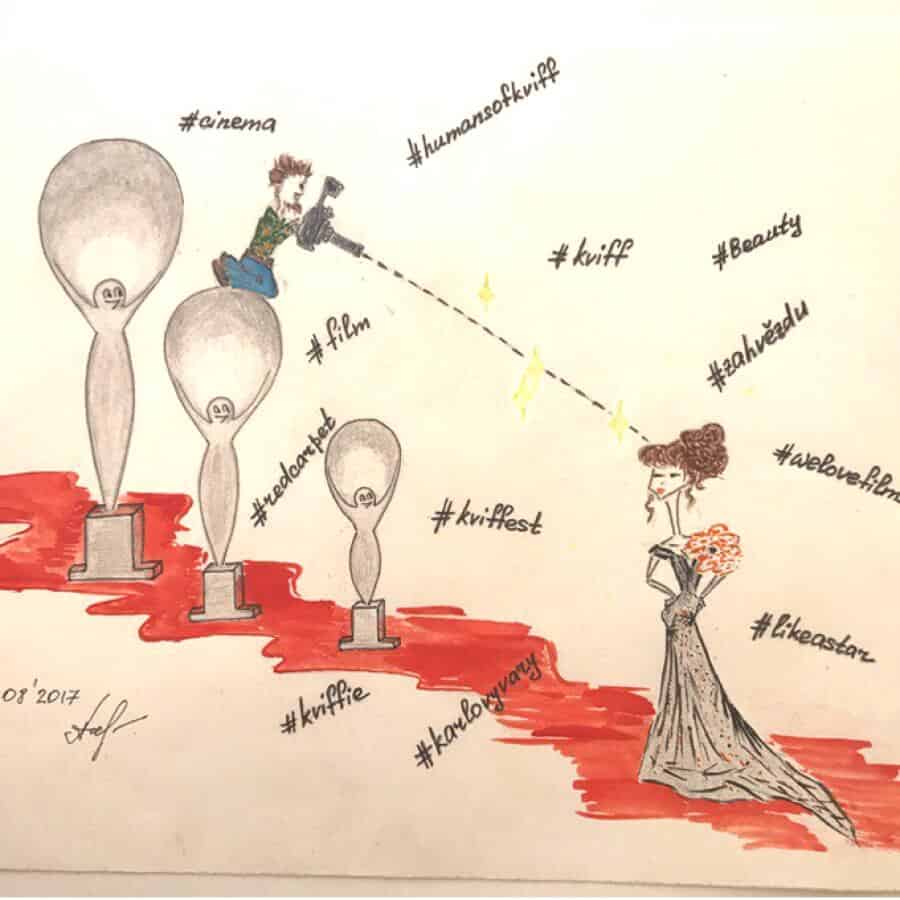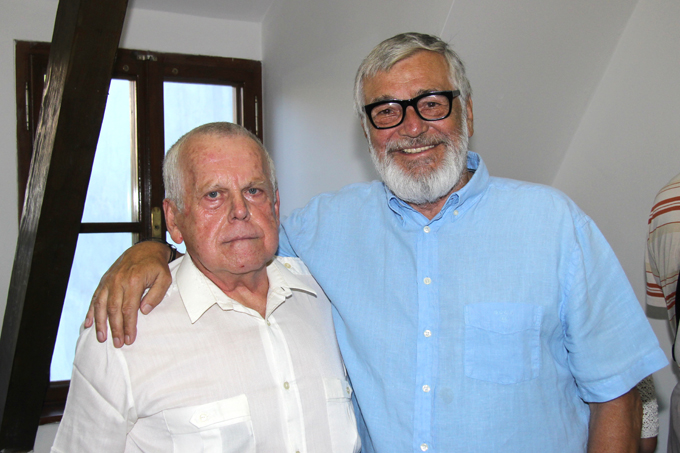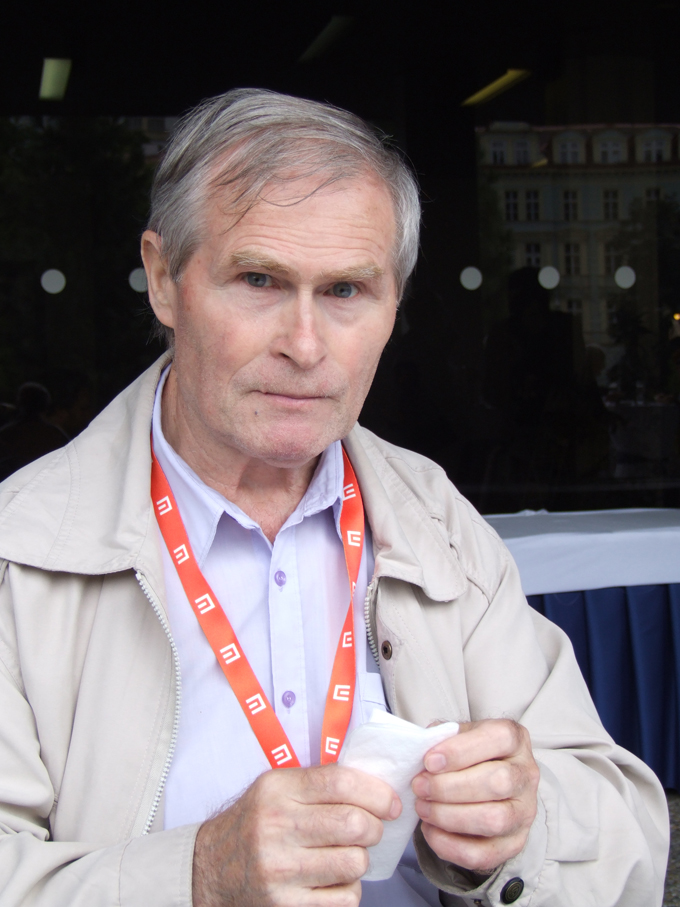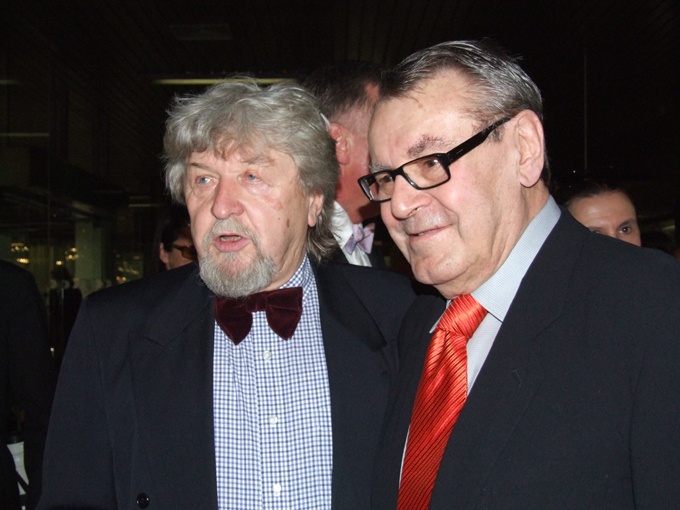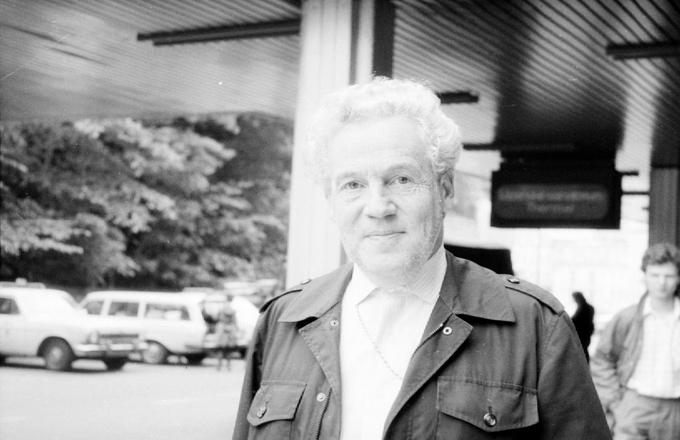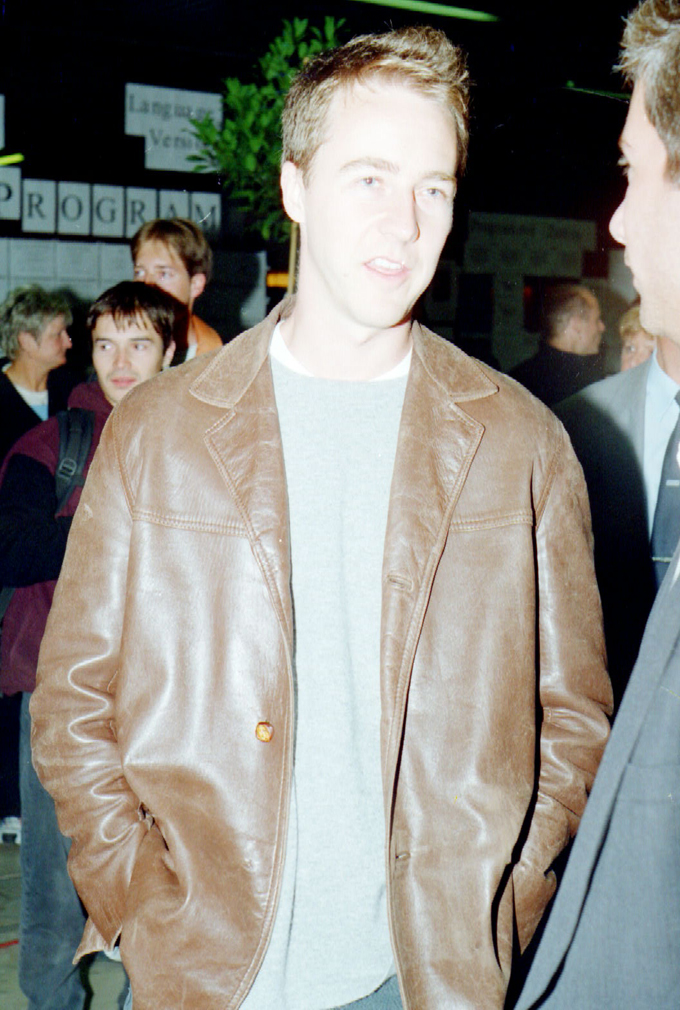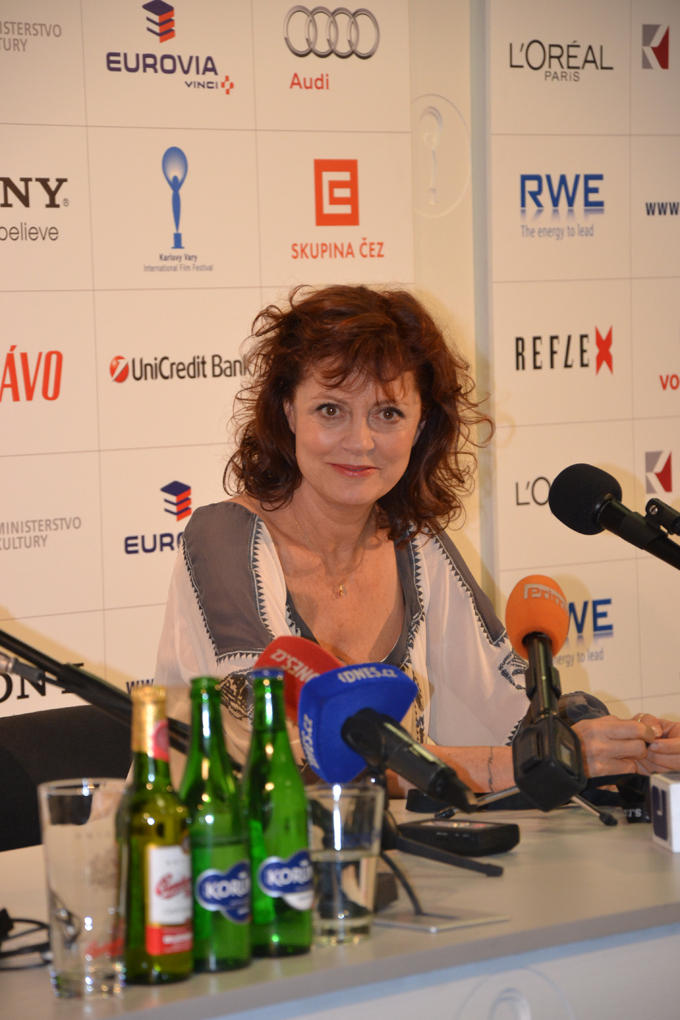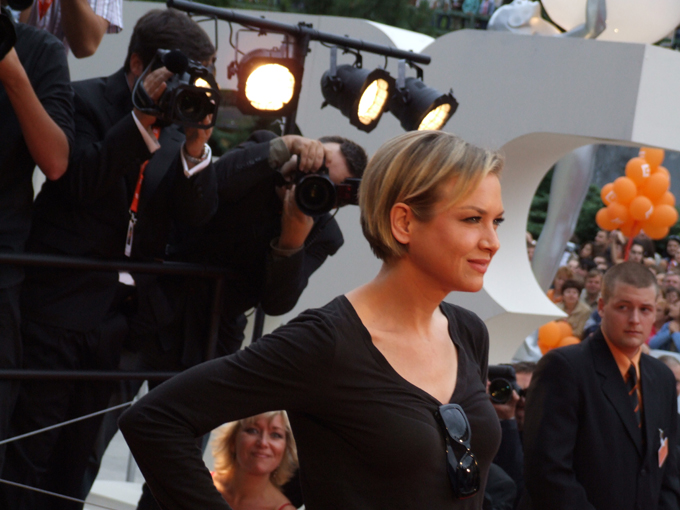Vladimir Zabransky, a teacher and photographer, is among those who remember the origins of the Karlovy Vary Film Festival and the way it has steadily grown. He has been making photos and taking autographs of the celebrities who have visited the festival for forty-nine consecutive years. Despite having an admirable work experience, he does not consider himself a professional in his line of work and humbly treats his passion for photography as a mere hobby. However, it's a hobby that has brought him global recognition and appreciation.
Vladimir Zabransky and J.Bartoška
I met Vladimir a couple of years ago at a press conference in Vary, and since that time we’ve seen each other on numerous occasions. He doesn’t go anywhere without his camera; whether it’s a dinner at a friend’s house or an official event, he finds a chance to click the shutter right in the middle of a conversation, trying to capture the interlocutor’s fleeting emotion.
2016 Jean Reno
He made his first photo shots when he was a child. “I was always fascinated by photography. My first photo camera didn’t have a flash, but it was still very special to me. If you take an ordinary camera which uses film, every frame has the size of 24 by 36 mm”, Vladimir points out. “The dimensions of the frame in that old photo camera were 12 by 24, which allowed me to take not thirty but, let’s say, fifty photos. At that time, it was a considerable advantage.” Nowadays, we can afford to come home from a holiday with as many as five hundred shots made on a digital camera, which we can view on a computer screen and delete the bad ones with a single click of a mouse. “When we shot on film, we had to think twice, if not ten times, whether it would be necessary to make two or four shots of a certain Mr. X”, the photographer nods his head. Even now he shoots as if his camera used film, not a memory card; perhaps it is a habit which developed over the years. “Why would you need millions of shots? It is absolutely unnecessary.”
Vladimir’s old German camera was replaced by a Russian “Smena”. “It was a wonderful camera, though it made good shots only in good weather. After a while, my mother gave me a flash. You had to connect it to an outlet, but at least I could shoot in any weather and not only outside but also indoors. I considered myself an amateur (though he attended a photography course at one point – editor’s notes) I did a lot of shootings. I even took the camera with me on holiday trips. And then the festival burst into my life”, Vladimir reminisces.
2015 Richard Gere
Photography during the day, photography during the night
“I couldn’t even imagine that my photos would attract anyone’s interest”, says the photographer. “I shot for my own pleasure and also collected autographs.” You can see nowadays how dozens of fans of a visiting celebrity will wait at the door of the press center with photos, albums, and pens at the ready. Today anyone can download a photo of a celebrity and print it in the nearest photo center. But things were quite different when Vladimir was young: having caught a valuable shot, Vladimir had to spend the whole night in an ordinary bathroom developing photos, so he could have a fresh photo at hand when it was time to ask for an autograph. “I used a regular hair dryer to make the photos dry faster, “ he says with a smile. “And when the morning came, I had to rush to the Thermal (a hotel in Karlovy Vary, the strategic and administrative center of the festival – Editor’s notes) to get the autograph. Actors were often amazed at how quickly I managed to prepare the photos. Certainly some pictures left much to be desired, because at that time it was extremely difficult to take a good shot. Therefore, when I didn’t have the photo, I asked them to leave a signature on a special card. That’s how it all started.”
Chronicles of the Festival
As the film festival gained momentum and acquired a worldwide recognition, the number of guests and films also increased, and the accompanying event program became more diverse. But how to keep in mind the history of this event and preserve it for future generations? Kvetoslav Krocha, the director of the Karlovy Vary Museum, who also kept the chronicles of the city, made this his responsibility. He was accompanied by none other than Vladimir Zabransky.
“I remember when we talked about it while drinking slivovica. He immediately shifted to first-name terms, despite being much older than I was. He was an incredibly intelligent and educated person who remembered literally everything. (Kvetoslav Krocha passed away in 2011 – editor’s notes). He offered me the opportunity to collaborate on a book, and I agreed without hesitation. Kvetoslav was responsible for the text, while I provided the photos.”
Mgr.Kvetoslav Krocha
The uniqueness of the photographs, the ones that were developed at night in an improvised laboratory, consisted in their strict systematization. Every single one of them was not only carefully stacked in accordance with the year but was also signed. “There was a signature on the back of every photo. For example, Miroslav Vorlicek, July 1, 1970, president of the jury, 17:30. At that time, I had to do everything myself, while today the camera does all the work for me. Kvetoslav Krocha was astonished and amazed because before that he had to inquire time and time again where and when was this or that picture had been taken. This is how the book, which brought Vladimir Zabransky widespread recognition, was created.
Krocha, the historian, continued to keep the chronicles and publish the brochures about the festival for no less than ten years. Afterward, the idea was adopted by Jiri Bartoshka (according to Vladimir, the world saw three or four brochures dedicated to the festival thanks to Bartoshka’s eagerness). Unfortunately, after the death of the historian, the process came to a halt. In 2015, a small breakthrough took place: the managers of the festival asked Vladimir Zabransky to prepare the chronicle, and his son agreed to help him. “However, nothing happened in 2016, and I guess nothing will be published this year (2017 – editor’s note), either,” laments Vladimir. “It is really too bad, because it is always difficult to retrieve history from bits and pieces of newspapers and the festival’s daily log. Besides, Krocha created the truly unique chronicles. He even knew what certain actors had for dinner! It would have been great to include such interesting details in the chronicles but, sadly, no one is interested in publishing them. As for me, everything is pretty much the same: I continue to make photos and collect autographs.
2009 Miroslav Ondříček and Miloš Forman
Or in some cases, autographs from this and the other world.
Despite the fact that the issue regarding the chronicles remains unresolved, Vladimir’s photo collection continues to grow and to be in requisition. In 2017, an exhibition dedicated to his works opened in his hometown of Slavkov. The photographs depicted the guests and the everyday occurrences at the festivals from several decades. Jiri Bartoshka and his colleagues (Kristof Mucha, the executive director, Karel Oh, the artistic director, Petr Lintimer, the production director) also visited the exhibition. “When I saw them before me, I felt like I my heart had skipped a beat, that’s how excited I was”, laughs Vladimir. “These are the four indispensable people who make this festival happen. I didn’t know what to expect!” However, I shouldn’t have worried. “Bartoshka liked the exhibition. He said a lot of nice things which almost made me cry. My style of shooting is a bit unconventional. I don’t make arrangements with anyone, I just ask them on the spot or take a random picture in motion or in an unfamiliar ambiance. The situation may be imperfect, but the photo will turn up to be very true to life, and this is, basically, what everyone likes.”
There is another reason why Vladimir’s work (I wouldn’t dare to call it a hobby) is remarkable: his photos feature the little-known and little-promoted people from the world of cinematography.
Erland Josephson
“Emmanuel Riva visited the festival in the ‘70s. She came as the chairman and the representative of the Czechoslovak-French friendship organization. I also have a photo of Erland Josephson. After I saw the movie about him, I was profoundly impressed by what he has accomplished in his life. Guess what, I have his photo as well as his autograph! Xavier Dolan was here in the ‘80s, four years before he received the Oscar. Even Mr. Krocha was unaware of that, so I had to tell him,” says Vladimir jokingly.
Edward Norton
What’s amusing is that not a single celebrity has refused when the photographer asked for a photo. Getting the autographs also wasn’t problematic; perhaps Edward Norton, the movie actor, could be counted as an exception because he has stubbornly refused to sign the precious card.
Susan Sarandon
There have also been plenty of memorable situations. “One of the festivals in Vary was attended by Susan Sarandon. I knew that she preferred to sign on a photograph, so I found a dictionary which contained an article about her as well as her picture and filmography. I brought it to the Grand Hall in Termal, where she had to give an interview after the feature presentation, which was her latest movie. The showing was over and the interview began with questions from the audience. I decided to take a risk and raised my hand. I asked her to sign the book and she waved to me invitingly. I stood up and headed towards the stage while all the people in the hall stared at me! Later, at home, I told my wife about this, and she said, “You are lucky that I wasn’t there. Otherwise, you would have already been a man without a wife (laughs).”
2007 Renné Zellweger
Vladimir’s current collection features about seven thousand autographs. He says that it is not a matter of quantity, but of quality: all collecting should be done purposefully, in keeping with a certain theme or event. It turns out that this hobby provides as much scope for dreaming as taking photographs. “I would love to get an autograph from Jack Nicholson”, admits Zabransky. Sometimes, such dreams come true in rather unusual ways. “I have an autograph from Leonard Bernstein which I received by mail as a response to an inquiry. I remember that I had been waiting for a long time for a response to my letter, but then I found out that he had passed away. And then, a month after his death, I got a letter which contained his autograph. It is obvious that he did it while he was still alive, then someone found it when sorting out his correspondence and sent it to me. I sat there, holding a piece of paper in my hand, and I couldn’t hold back tears. Dear God, I just got a letter from the other world.”
Photos: Vladimir Zabransky
Support us!
All your donations will be used to pay the magazine’s journalists and to support the ongoing costs of maintaining the site.
Share this post
Interested in co-operating with us?
We are open to co-operation from writers and businesses alike. You can reach us on our email at cooperations@youthtimemag.com/magazine@youthtimemag.com and we will get back to you as quick as we can.
